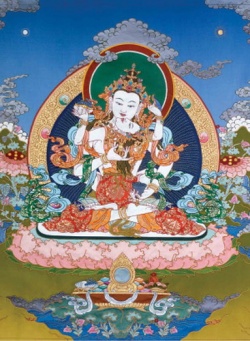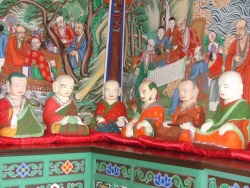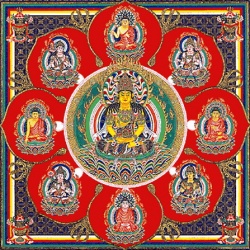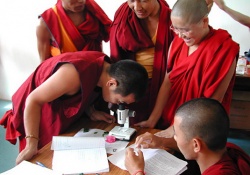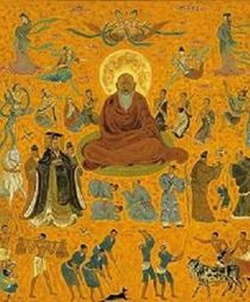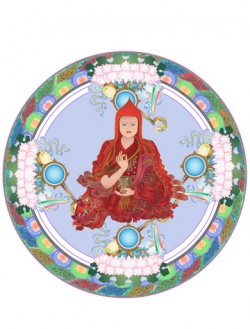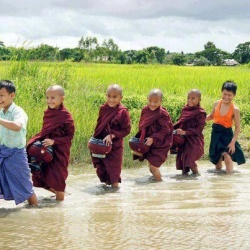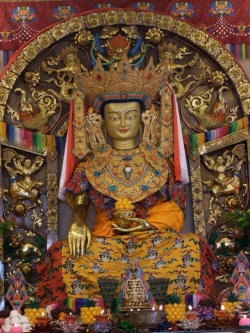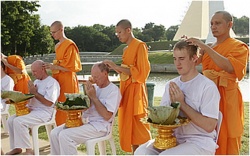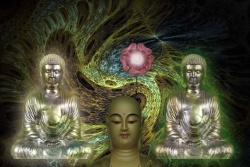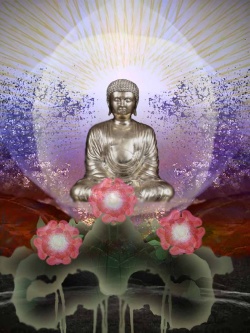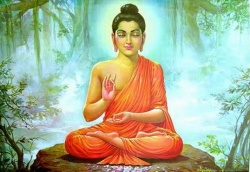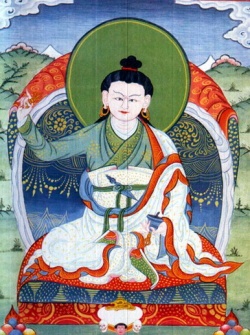Difference between revisions of "Lesser, Greater and Tantric Ways to Enlightenment"
m (Text replacement - "application" to "application") |
|||
| Line 1: | Line 1: | ||
<nomobile>{{DisplayImages|3618|524|1249|2363|1726|2509|1607|438|2380|4185|2431|4282|4334|643|1498}}</nomobile> | <nomobile>{{DisplayImages|3618|524|1249|2363|1726|2509|1607|438|2380|4185|2431|4282|4334|643|1498}}</nomobile> | ||
| + | |||
| + | |||
| + | |||
| + | |||
<poem> | <poem> | ||
| − | [[Buddhism]], whether a [[philosophy]], a system of techniques for treating [[mental suffering]], or a [[religion]], is generally considered to have three main [[forms]] today. They used to be classified: [[Hinayana]], [[Mahayana]] and [[Vajrayana]]. However, those terms actually refer to aspects of the [[Buddha's teaching]]. It is unlikely that any [[Dharma]] [[practitioner]] works with only a single one of the three. | + | [[Buddhism]], whether a [[philosophy]], a system of [[techniques]] for treating [[mental suffering]], or a [[religion]], is generally considered to have three main [[forms]] today. They used to be classified: [[Hinayana]], [[Mahayana]] and [[Vajrayana]]. However, those terms actually refer to aspects of the [[Buddha's teaching]]. It is unlikely that any [[Dharma]] [[practitioner]] works with only a single one of the three. |
[[Hinayana]] | [[Hinayana]] | ||
The [[Hinayana]], meaning Lesser (or, narrower) [[Vehicle]], focuses on the {{Wiki|individual}} and on a personal [[form]] of {{Wiki|salvation}}. Inspired by the [[Four Truths]] and the application of the {{Wiki|principles}} of the [[Middle Way]], [[Hinayana]] [[Buddhists]] are primarily concerned with their [[own]] [[spiritual]] improvement. Certainly "No man is an [[island]]," but one cannot be of use to other [[people]] without [[self-knowledge]] and [[discipline]] which produces the assurance to develop and act out of [[compassion]]. | The [[Hinayana]], meaning Lesser (or, narrower) [[Vehicle]], focuses on the {{Wiki|individual}} and on a personal [[form]] of {{Wiki|salvation}}. Inspired by the [[Four Truths]] and the application of the {{Wiki|principles}} of the [[Middle Way]], [[Hinayana]] [[Buddhists]] are primarily concerned with their [[own]] [[spiritual]] improvement. Certainly "No man is an [[island]]," but one cannot be of use to other [[people]] without [[self-knowledge]] and [[discipline]] which produces the assurance to develop and act out of [[compassion]]. | ||
| + | |||
In the "[[Gihi Sutta]]," (The [[Householder]]) found in [[Anguttara Nikaya]] V.179, the [[Buddha]] assures persons doing {{Wiki|individual}} practice: | In the "[[Gihi Sutta]]," (The [[Householder]]) found in [[Anguttara Nikaya]] V.179, the [[Buddha]] assures persons doing {{Wiki|individual}} practice: | ||
| Line 42: | Line 47: | ||
Indeed, [[knowing]] what we know about [[relativity]] and [[atomic]] {{Wiki|theory}}, we realize that we are each composed of the [[essential]] [[elements]] of others. There is no [[logical]] conclusion other than to adopt an inclusive or [[Mahayana]] ([[Great Vehicle]]) approach to [[Buddhism]]. The [[enlightened]] regard or [[compassion]] which encourages us in this view is called in [[Sanskrit]], [[bodhicitta]]. | Indeed, [[knowing]] what we know about [[relativity]] and [[atomic]] {{Wiki|theory}}, we realize that we are each composed of the [[essential]] [[elements]] of others. There is no [[logical]] conclusion other than to adopt an inclusive or [[Mahayana]] ([[Great Vehicle]]) approach to [[Buddhism]]. The [[enlightened]] regard or [[compassion]] which encourages us in this view is called in [[Sanskrit]], [[bodhicitta]]. | ||
| − | This [[understanding]] of the connection among all [[beings]] is the [[reason]] why, though some have equated [[Hinayana Buddhism]] with the [[Theravada school]], that is definitely not a [[correct view]]. The {{Wiki|concept}} of [[bodhicitta]] is a certainly a [[doctrine]] found among [[Theravadins]] such as the [[Buddhists]] of [[Shri Lanka]] and [[Thailand]]. | + | This [[understanding]] of the [[connection]] among all [[beings]] is the [[reason]] why, though some have equated [[Hinayana Buddhism]] with the [[Theravada school]], that is definitely not a [[correct view]]. The {{Wiki|concept}} of [[bodhicitta]] is a certainly a [[doctrine]] found among [[Theravadins]] such as the [[Buddhists]] of [[Shri Lanka]] and [[Thailand]]. |
[[Vajrayana]] | [[Vajrayana]] | ||
| − | The historical [[founder of Buddhism]] is generally considered to have [[taught]] different approaches for the needs or inclinations of different [[people]]. After his [[Awakening]] to [[full consciousness]] -- usually referred to as his [[Enlightenment]] -- he is said to have given three [[sermons]] or "Turnings of the [[Dharma Wheel]]" which are understood not only as stages on a [[path]] but as different approaches. The first was at the [[Deer Park]] when he [[taught]] moderation and [[morality]], the second at [[Vulture's Peak]] when he [[taught]] concerning [[wisdom]], the third Turning concerned [[meditation]] and clarity. He is said to have [[taught]] a fourth approach assuming the [[form]] of [[Vajradhara]] in order to do so. That topic and its method is the [[Vajrayana]]. | + | The historical [[founder of Buddhism]] is generally considered to have [[taught]] different approaches for the needs or inclinations of different [[people]]. After his [[Awakening]] to [[full consciousness]] -- usually referred to as his [[Enlightenment]] -- he is said to have given three [[sermons]] or "Turnings of the [[Dharma Wheel]]" which are understood not only as stages on a [[path]] but as different |
| + | |||
| + | approaches. The first was at the [[Deer Park]] when he [[taught]] moderation and [[morality]], the second at [[Vulture's Peak]] when he [[taught]] concerning [[wisdom]], the third Turning concerned [[meditation]] and clarity. He is said to have [[taught]] a fourth approach assuming the [[form]] of [[Vajradhara]] in order to do so. That topic and its method is the [[Vajrayana]]. | ||
| Line 52: | Line 59: | ||
The [[dorje]] is usually paired with the [[ghanta]] or hand-bell, which stands for "[[Emptiness]]" (not to be confused with "[[nothingness]].") It may be [[thought]] of as a {{Wiki|female}} [[symbol]], but it represents [[wisdom]] or [[enlightened]] [[knowledge]]. The [[bell]] is especially apt as a [[Buddhist]] [[symbol]] because, though [[sound]] comes from it, it is not [[inherent]] to the [[bell]]; nor does the [[bell]] contain it. | The [[dorje]] is usually paired with the [[ghanta]] or hand-bell, which stands for "[[Emptiness]]" (not to be confused with "[[nothingness]].") It may be [[thought]] of as a {{Wiki|female}} [[symbol]], but it represents [[wisdom]] or [[enlightened]] [[knowledge]]. The [[bell]] is especially apt as a [[Buddhist]] [[symbol]] because, though [[sound]] comes from it, it is not [[inherent]] to the [[bell]]; nor does the [[bell]] contain it. | ||
| − | Wherever the two items are found together, we have the indication of the [[vajrayana]] -- the [[form]] of [[Buddhism]] that uses radical techniques skilfully applied in order to hasten [[enlightenment]]. | + | Wherever the two items are found together, we have the indication of the [[vajrayana]] -- the [[form]] of [[Buddhism]] that uses radical [[techniques]] skilfully applied in order to hasten [[enlightenment]]. |
In [[Buddhism]], there is no [[doubt]] that [[Vajrayana]] is an aspect of the [[Mahayana]] or inclusive approach. | In [[Buddhism]], there is no [[doubt]] that [[Vajrayana]] is an aspect of the [[Mahayana]] or inclusive approach. | ||
| − | It is a way that derives from the [[Indian]] [[tantric tradition]] which is a closely monitored, personal [[transmission]] of special methods. Often misunderstood, the [[Sanskrit]] [[word]] [[tantra]] denotes the warp threads of a fabric, or a [[Wikipedia:Rope|cord]] that strings together a series of beads as in a rosary or [[mala]]. [[Tantric]] refers to the unbroken continuity of an applied [[teaching]]. It is almost {{Wiki|synonymous}} with the [[word]], [[yogic]] (the {{Wiki|adjective}} formed from the [[Sanskrit]] [[word]] [[yoga]].) | + | It is a way that derives from the [[Indian]] [[tantric tradition]] which is a closely monitored, personal [[transmission]] of special [[methods]]. Often misunderstood, the [[Sanskrit]] [[word]] [[tantra]] denotes the warp threads of a fabric, or a [[Wikipedia:Rope|cord]] that strings together a series of [[beads]] as in a rosary or [[mala]]. [[Tantric]] refers to the unbroken continuity of an applied [[teaching]]. It is almost {{Wiki|synonymous}} with the [[word]], [[yogic]] (the {{Wiki|adjective}} formed from the [[Sanskrit]] [[word]] [[yoga]].) |
| − | The [[tantric]] method uses [[ancient]] devices, {{Wiki|substances}}, techniques and [[rituals]] to re-shape practitioners’ [[consciousness]] so that habitual [[thought]] and {{Wiki|behaviour}} patterns which are often detrimental, neurotic or at the least, rigid, can be abandoned in favour of [[enlightened awareness]]. | + | The [[tantric]] method uses [[ancient]] devices, {{Wiki|substances}}, [[techniques]] and [[rituals]] to re-shape practitioners’ [[consciousness]] so that habitual [[thought]] and {{Wiki|behaviour}} patterns which are often detrimental, neurotic or at the least, rigid, can be abandoned in favour of [[enlightened awareness]]. |
[[Venerable]] [[Thrangu Rinpoche]] describes the [[tantric]], or [[vajrayana]], process as consisting of [[five paths]] or stages: of [[accumulation]], of junction, of [[insight]], of [[cultivation]] and finally, of non-study. | [[Venerable]] [[Thrangu Rinpoche]] describes the [[tantric]], or [[vajrayana]], process as consisting of [[five paths]] or stages: of [[accumulation]], of junction, of [[insight]], of [[cultivation]] and finally, of non-study. | ||
| Line 79: | Line 86: | ||
A Geographical {{Wiki|Classification}} | A Geographical {{Wiki|Classification}} | ||
| − | [[Buddhism]] may also be classified according to {{Wiki|geography}}. We speak of Northern, Southern, Eastern and [[Western]] types of [[Buddhism]]. In the first three, [[Buddhism]] is still an intrinsic part of the {{Wiki|culture}}. | + | [[Buddhism]] may also be classified according to {{Wiki|geography}}. We speak of [[Northern]], Southern, Eastern and [[Western]] types of [[Buddhism]]. In the first three, [[Buddhism]] is still an intrinsic part of the {{Wiki|culture}}. |
| − | By Northern, we mean [[Buddhism]] as it is in [[Tibet]], {{Wiki|Ladakh}}, [[Mongolia]] and [[Nepal]]. [[Pilgrimage]] and support of [[monasteries]] are important, as is personal [[devotion]] to certain high [[teachers]] such as the [[Dalai Lama]] and the [[Gyalwa Karmapa]]. Since travel to [[India]] is difficult, a system of a parallel or shadow {{Wiki|holy}} {{Wiki|geography}} has arisen such that a devoted [[person]] can travel to [[sacred]] places in [[Tibet]], for example, that are almost considered the {{Wiki|equivalent}} of sites in [[India]] where there are [[relics]] of [[Buddha Shakyamuni]], and where events in his [[life]] took place. | + | By [[Northern]], we mean [[Buddhism]] as it is in [[Tibet]], {{Wiki|Ladakh}}, [[Mongolia]] and [[Nepal]]. [[Pilgrimage]] and support of [[monasteries]] are important, as is personal [[devotion]] to certain high [[teachers]] such as the [[Dalai Lama]] and the [[Gyalwa Karmapa]]. Since travel to [[India]] is difficult, a system of a parallel or shadow {{Wiki|holy}} {{Wiki|geography}} has arisen such that a |
| + | |||
| + | devoted [[person]] can travel to [[sacred]] places in [[Tibet]], for example, that are almost considered the {{Wiki|equivalent}} of sites in [[India]] where there are [[relics]] of [[Buddha Shakyamuni]], and where events in his [[life]] took place. | ||
The [[scriptures]] that play an important role in this expression of the [[dharma]] include the [[Prajnaparamita]] {{Wiki|literature}}, from a lengthy 100, 000-verse [[form]] to the brief [[Heart Sutra]], as well as various [[tantric]] manuals, {{Wiki|biographies}}, and songs of inspiration. An example of the [[latter]] is the 100, 000 Songs of [[Milarepa]]. | The [[scriptures]] that play an important role in this expression of the [[dharma]] include the [[Prajnaparamita]] {{Wiki|literature}}, from a lengthy 100, 000-verse [[form]] to the brief [[Heart Sutra]], as well as various [[tantric]] manuals, {{Wiki|biographies}}, and songs of inspiration. An example of the [[latter]] is the 100, 000 Songs of [[Milarepa]]. | ||
| − | Beginners might start with [[Thrangu Rinpoche's]] [[Life]] and [[Spiritual]] Songs of [[Milarepa]] | + | |
| + | Beginners might start with [[Thrangu Rinpoche's]] [[Life]] and [[Spiritual]] Songs of [[Milarepa]] | ||
| + | |||
Practices include the maintenance of household [[shrines]], and [[prayer]] and the saying of [[mantras]] is an intrinsic aspect of daily [[life]]. [[Prostrations]] are performed as part of [[Buddhist practice]] in [[devotion]]. The daily [[diet]] is generally non-vegetarian. When [[people]] are ill or when [[thinking]] of making changes in their life-situation. the opinion of the [[lama]] is consulted. | Practices include the maintenance of household [[shrines]], and [[prayer]] and the saying of [[mantras]] is an intrinsic aspect of daily [[life]]. [[Prostrations]] are performed as part of [[Buddhist practice]] in [[devotion]]. The daily [[diet]] is generally non-vegetarian. When [[people]] are ill or when [[thinking]] of making changes in their life-situation. the opinion of the [[lama]] is consulted. | ||
| − | Eastern [[Buddhism]] mainly comprises the [[dharma]] as it is understood and practiced in [[China]], [[Korea]], [[Japan]] and [[Vietnam]]. [[Dharma]] in these countries is inextricably mixed with the original customs and [[beliefs]] of the [[ancient]] {{Wiki|culture}}, especially the vestiges of [[Taoism]] and [[Wikipedia:Confucianism|Confucianism]] that still remain. Though [[Buddhism]] reached [[China]] in | + | Eastern [[Buddhism]] mainly comprises the [[dharma]] as it is understood and practiced in [[China]], [[Korea]], [[Japan]] and [[Vietnam]]. [[Dharma]] in these countries is inextricably mixed with the original customs and [[beliefs]] of the [[ancient]] {{Wiki|culture}}, |
| + | |||
| + | especially the vestiges of [[Taoism]] and [[Wikipedia:Confucianism|Confucianism]] that still remain. Though [[Buddhism]] reached [[China]] in the 1st century CE, it was not until the 6th that it arrived in [[Japan]]. The [[canon]] of {{Wiki|Chinese}} [[Buddhist scripture]] is very extensive. [[Ch'an]] ([[Zen]], in [[Japanese]]) took [[root]], and the [[Pureland]] schools originate here. | ||
| + | |||
| + | |||
| + | An essay on the [[doctrinal]] [[characteristics]] of [[Chinese Buddhism]] -- one of them is an inclination towards {{Wiki|enumeration}} and categorization. | ||
| − | + | [[Southern Buddhism]] is characterized by the support of {{Wiki|institutions}} and the [[monastic order]] by the {{Wiki|community}} in general. The [[attitude]] to practice is somewhat [[relaxed]], though [[devotion]] through [[ritual]] is widely seen. Though [[education]] | |
| − | + | may be provided by [[monasteries]] supported by local communities, [[spiritual]] progress is judged by the [[merit]] accrued through [[generosity]] and good works. [[Monks and nuns]] rely on the local populations for material support and they, in turn, repay the lay {{Wiki|community}} through their presence as inspiration and example, and by [[prayer]] and [[devotion]] on their behalf. | |
Sometimes this expression of [[Buddhism]] is referred to as [[Hinayana Buddhism]], but it is not. It certainly includes [[concern]] for others, as exemplified in the [[Pali]] [[phrase]], [[Idam Te Puñña Kammam]]. This an actual [[dedication of merit]]: "May the [[merit]] of my [[actions]] be shared with all [[beings]], so there is less [[suffering]]." {{Wiki|Adherents}} call it the [[Way of the Elders]] or [[Theravada Buddhism]]. | Sometimes this expression of [[Buddhism]] is referred to as [[Hinayana Buddhism]], but it is not. It certainly includes [[concern]] for others, as exemplified in the [[Pali]] [[phrase]], [[Idam Te Puñña Kammam]]. This an actual [[dedication of merit]]: "May the [[merit]] of my [[actions]] be shared with all [[beings]], so there is less [[suffering]]." {{Wiki|Adherents}} call it the [[Way of the Elders]] or [[Theravada Buddhism]]. | ||
| Line 256: | Line 272: | ||
[[Pureland]]: comparable to (but not [[identical]] with) a [[heavenly]] [[paradise]]. A type of [[existence]] where [[Enlightenment]], or [[Awakening]], is more likely to occur. | [[Pureland]]: comparable to (but not [[identical]] with) a [[heavenly]] [[paradise]]. A type of [[existence]] where [[Enlightenment]], or [[Awakening]], is more likely to occur. | ||
| − | [[Western]]: This is not merely a geographic description. It refers to lands and cultures that are heir to the {{Wiki|Roman}} style of [[organization]] that spread by means of Imperialism / colonization via northern {{Wiki|Europe}} and then, to the Americas. The [[mythology]] or foundation for [[belief]] is {{Wiki|Judeo-Christian}}. It includes most of Polynesia and the lands "down under." Westernization continues [[to increase]] via television, radio and popular films, cds and the Internet. | + | [[Western]]: This is not merely a geographic description. It refers to lands and cultures that are heir to the {{Wiki|Roman}} style of [[organization]] that spread by means of Imperialism / colonization via northern {{Wiki|Europe}} and then, to the Americas. The [[mythology]] or foundation for [[belief]] is {{Wiki|Judeo-Christian}}. It includes most of Polynesia and the lands "down under." Westernization continues [[to increase]] via television, radio and popular films, cds and the [[Internet]]. |
</poem> | </poem> | ||
{{R}} | {{R}} | ||
[http://www.khandro.net/buddhism_paths.htm] | [http://www.khandro.net/buddhism_paths.htm] | ||
[[Category:Enlightenment]] | [[Category:Enlightenment]] | ||
Latest revision as of 22:43, 15 February 2024
Buddhism, whether a philosophy, a system of techniques for treating mental suffering, or a religion, is generally considered to have three main forms today. They used to be classified: Hinayana, Mahayana and Vajrayana. However, those terms actually refer to aspects of the Buddha's teaching. It is unlikely that any Dharma practitioner works with only a single one of the three.
Hinayana
The Hinayana, meaning Lesser (or, narrower) Vehicle, focuses on the individual and on a personal form of salvation. Inspired by the Four Truths and the application of the principles of the Middle Way, Hinayana Buddhists are primarily concerned with their own spiritual improvement. Certainly "No man is an island," but one cannot be of use to other people without self-knowledge and discipline which produces the assurance to develop and act out of compassion.
In the "Gihi Sutta," (The Householder) found in Anguttara Nikaya V.179, the Buddha assures persons doing individual practice:
"Sariputta, when you know of a householder clothed in white, that he is restrained in terms of the five training rules and that he obtains at will, without difficulty, without hardship, four pleasant mental abidings in the here & now, then if he wants he may state about himself: 'Hell is ended; animal wombs are ended; the state of the hungry shades is ended; states of deprivation, destitution, the bad bourns are ended! I am a stream-winner, steadfast, never again destined for states of woe, headed for self-awakening!' "
Although the expression Hinayana is sometimes found to be distasteful, it is merely a way of referring to the orthodox view that focuses on personal salvation. It is not a term of disparagement, nor is it intended to be synonymous with Theravadin or "Southern" Buddhism.
Pratyekas and Shravakas
It is said that there are enlightened beings called pratyeka buddhas who are completely absorbed in pure consciousness and do not interact with others. There is also the group called shravakas, who attend to the Buddha's dharma yet they also do not interact.
The Pali canon [which not long ago used to be the only version of Buddhist scripture available to readers of European languages presents the Theravadin view. The Mahayana sutras present the sutric Mahayana view. The Vajrayana includes both views and the tantras.
You can definitely attain arhatship or become a pratyeka-Buddha (of course becoming a pratyeka-Buddha requires eons and then you end up not teaching) following the Theravadin path.
You can also become a stream-enterer, once-returner, or never-returner.
The Vajrayana doesn't deny this.
It does assert that eventually arhats and pratyeka-Buddhas will be roused from nirvana and become Mahayana Bodhisattvas and then finally work to become fully enlightened Buddhas.
There are degrees of enlightenment and Arhats are enlightened. But they still have subtle obscurations, from the Vajrayana perspective. Arhatship isn't full and perfect Buddhahood.
If you follow the sutric Mahayana path it takes 3 incalculable eons. This is also the same for the Theravadin Bodhisattva path.
So arhatship looks pretty good -- you can do it within 7 lifetimes if you attain stream-entry in this life. The Vajrayana just says that it'll delay final Buddha-hood. The Vajrayana focuses on attaining full and perfect Buddhahood for the benefit of all beings. In the Vajrayana context, the term enlightenment is usually taken to mean the full enlightenment of a Buddha.
For more about reconciling the traditions, see below.
Mahayana
Nowadays, due to our understanding of ecology and the inter-relatedness of all things, which is fostered by the many sophisticated means of communication at our disposal, we quickly become convinced of the necessity of helping others.
Indeed, knowing what we know about relativity and atomic theory, we realize that we are each composed of the essential elements of others. There is no logical conclusion other than to adopt an inclusive or Mahayana (Great Vehicle) approach to Buddhism. The enlightened regard or compassion which encourages us in this view is called in Sanskrit, bodhicitta.
This understanding of the connection among all beings is the reason why, though some have equated Hinayana Buddhism with the Theravada school, that is definitely not a correct view. The concept of bodhicitta is a certainly a doctrine found among Theravadins such as the Buddhists of Shri Lanka and Thailand.
Vajrayana
The historical founder of Buddhism is generally considered to have taught different approaches for the needs or inclinations of different people. After his Awakening to full consciousness -- usually referred to as his Enlightenment -- he is said to have given three sermons or "Turnings of the Dharma Wheel" which are understood not only as stages on a path but as different
approaches. The first was at the Deer Park when he taught moderation and morality, the second at Vulture's Peak when he taught concerning wisdom, the third Turning concerned meditation and clarity. He is said to have taught a fourth approach assuming the form of Vajradhara in order to do so. That topic and its method is the Vajrayana.
Vajrayana has been called the way of the thunderbolt or vajra (Tibetan: dorje) which is a mythological object described as firm, dense, heavy and indestructible. It is like a weapon made of diamond. The connotation of the word also includes the suddenness of a clap of thunder. The dorje is sometimes viewed as a male symbol because of its shape, but it represents "skillful means" -- method, or technique.
The dorje is usually paired with the ghanta or hand-bell, which stands for "Emptiness" (not to be confused with "nothingness.") It may be thought of as a female symbol, but it represents wisdom or enlightened knowledge. The bell is especially apt as a Buddhist symbol because, though sound comes from it, it is not inherent to the bell; nor does the bell contain it.
Wherever the two items are found together, we have the indication of the vajrayana -- the form of Buddhism that uses radical techniques skilfully applied in order to hasten enlightenment.
In Buddhism, there is no doubt that Vajrayana is an aspect of the Mahayana or inclusive approach.
It is a way that derives from the Indian tantric tradition which is a closely monitored, personal transmission of special methods. Often misunderstood, the Sanskrit word tantra denotes the warp threads of a fabric, or a cord that strings together a series of beads as in a rosary or mala. Tantric refers to the unbroken continuity of an applied teaching. It is almost synonymous with the word, yogic (the adjective formed from the Sanskrit word yoga.)
The tantric method uses ancient devices, substances, techniques and rituals to re-shape practitioners’ consciousness so that habitual thought and behaviour patterns which are often detrimental, neurotic or at the least, rigid, can be abandoned in favour of enlightened awareness.
Venerable Thrangu Rinpoche describes the tantric, or vajrayana, process as consisting of five paths or stages: of accumulation, of junction, of insight, of cultivation and finally, of non-study.
Nowadays, there are usually manuals (tantras) for these types of practice, which include a text with accompanying prayers and the order of procedure, instructions for its implementation, and some advice from an experienced practitioner. Despite the availability of these manuals, a practice cannot really be considered tantric without the genuine transmission from a guide or mentor. In Tibetan Buddhism, that person is the lama.
Triyana
The form of Buddhism which was brought from India to Tibet incorporates all three ways mentioned above. It can therefore be called Triyana Dharma.
Virupa, the Indian mahasiddha (ca. 650 CE) taught there are three views of the path -- as seen by
1. someone working towards self-realization Hinayana
2. someone who intensely wishes to work for the sake of all beings Mahayana and
3. one who sees through the dream-like delusion and realizes non-duality Vajrayana.
______________________________________
A Geographical Classification
Buddhism may also be classified according to geography. We speak of Northern, Southern, Eastern and Western types of Buddhism. In the first three, Buddhism is still an intrinsic part of the culture.
By Northern, we mean Buddhism as it is in Tibet, Ladakh, Mongolia and Nepal. Pilgrimage and support of monasteries are important, as is personal devotion to certain high teachers such as the Dalai Lama and the Gyalwa Karmapa. Since travel to India is difficult, a system of a parallel or shadow holy geography has arisen such that a
devoted person can travel to sacred places in Tibet, for example, that are almost considered the equivalent of sites in India where there are relics of Buddha Shakyamuni, and where events in his life took place.
The scriptures that play an important role in this expression of the dharma include the Prajnaparamita literature, from a lengthy 100, 000-verse form to the brief Heart Sutra, as well as various tantric manuals, biographies, and songs of inspiration. An example of the latter is the 100, 000 Songs of Milarepa.
Beginners might start with Thrangu Rinpoche's Life and Spiritual Songs of Milarepa
Practices include the maintenance of household shrines, and prayer and the saying of mantras is an intrinsic aspect of daily life. Prostrations are performed as part of Buddhist practice in devotion. The daily diet is generally non-vegetarian. When people are ill or when thinking of making changes in their life-situation. the opinion of the lama is consulted.
Eastern Buddhism mainly comprises the dharma as it is understood and practiced in China, Korea, Japan and Vietnam. Dharma in these countries is inextricably mixed with the original customs and beliefs of the ancient culture,
especially the vestiges of Taoism and Confucianism that still remain. Though Buddhism reached China in the 1st century CE, it was not until the 6th that it arrived in Japan. The canon of Chinese Buddhist scripture is very extensive. Ch'an (Zen, in Japanese) took root, and the Pureland schools originate here.
An essay on the doctrinal characteristics of Chinese Buddhism -- one of them is an inclination towards enumeration and categorization.
Southern Buddhism is characterized by the support of institutions and the monastic order by the community in general. The attitude to practice is somewhat relaxed, though devotion through ritual is widely seen. Though education
may be provided by monasteries supported by local communities, spiritual progress is judged by the merit accrued through generosity and good works. Monks and nuns rely on the local populations for material support and they, in turn, repay the lay community through their presence as inspiration and example, and by prayer and devotion on their behalf.
Sometimes this expression of Buddhism is referred to as Hinayana Buddhism, but it is not. It certainly includes concern for others, as exemplified in the Pali phrase, Idam Te Puñña Kammam. This an actual dedication of merit: "May the merit of my actions be shared with all beings, so there is less suffering." Adherents call it the Way of the Elders or Theravada Buddhism.
BBC World Service on Buddhism
R. P. Hayes' essay, The Dharma Tree addresses the question, "What is happening to Buddhism in its traditional cultural centres?"
At its height, Buddhism had spread through most of Asia.
Western Buddhism
Western Buddhism includes all Buddhist paths and a wide variety of denominations. The various dharma groups derive primarily from the contacts made during the British (and French, Dutch, Russian, American, etc.) colonial experience. These tantalizing glimpses were then fostered by a growing number of publications of, and about, the Dhammapada, The Jatakas and all the other kinds of Buddhist literature that began to appear in Western languages. A major turning point certainly occurred with the publication of Friedrich Maximilian Müller's (1823-1900) monumental work, The Sacred Books of the East.
More about Forms of Buddhism in the West.
Dalai Lama's 1993 conference on Dharma in the West.
Reconciling the Various Traditions
Khyabje Kalu Rinpoche, in Luminous Mind:
"In Buddhism, whether Japan, Laos, Cambodia, Vietnam, Thailand, Burma, Sri Lanka, Korea, China or Tibet, all the teachings and Dharma practices have the same foundations, so the practitioners of the various schools are brothers and sisters.
Since each tradition and lineages constitutes an authentic, complete teaching, we might ask, "Then why are there so many of them?" In general, their variety corresponds to beings' varied capacities and inclination. Each system exists to meet the particular needs and abilities of different people endowed with different mentalities.
All of the traditions insist on the discipline proceeding from an understanding of karma as a way of radically changing our conditioned thinking and as a basis for proceeding to buddhahood.
In general, to have faith in all the traditions is a sign of profound understanding of teachings. However, it is absolutely necessary to engage in one given tradition, to received details instructions in it, and to be introduced to its existential practices and then, it is proper to practice mainly those teachings.
So, regardless of schools or sangha from whom we receive teachings, we should try to adopt an impartial attitude and devote ourselves to practice with total aspiration. Otherwise, merely remembering some phrases and here and there, taking in only certain aspects of the teachings, and playing at being practitioners will make it quite difficult for us to gain any significant benefits."
Daisetz T. Suzuki, the great Zen teacher (The Eastern Buddhist, v.4, no.2) acknowledging the role of the Vajrayana, said:
"Buddhism supplies us with so many gates to enter into the truth because of such a variety of human characters and temperaments and environments due to diversities of karma. This is plainly depicted and taught by the Buddha himself when he says that the same water drunk by the cow and the cobra turns in one case into nourishing milk and in the other into deadly poison, and that medicine is to be given according to disease. This is called the doctrine of skillful means . . . ."
________________________________________________________________________
In The Heart of Buddhism, Guy Claxton rated three types of Buddhism in an attempt to assist those trying to decide which way of approaching the Dharma best suits them. It is a superficial system to be sure, but it may help someone who feels a need to choose before meeting any actual practitioners.
He rates the Theravadin, the Zen, and the Tibetan traditions using a 3-star scale. Bear in mind that the highest number does not rate quality of experience, but rather means "most likely to be expected."
Aspects
Theravada
Zen
Tibetan
Reverence for lineage
2 stars
2 stars
3 stars
Surrender to Teacher
2 stars
3 stars
2 stars
Earnestness
3 stars
3 stars
2 stars
Exotic (Ritual Chants)
2 stars
2 stars
3 stars
Moral Discipline
3 stars
2 stars
1 star
Effort in Meditation
2 stars
3 stars
1 star
Superior/Exclusive
2 stars
3 stars
3 stars
Brain-strain
1 star
3 stars
2 stars
Respect for intellect
2 stars
1 star
3 stars
Weird Experiences
1 star
3 stars
3 stars
__________________________________________________________________
Pureland: comparable to (but not identical with) a heavenly paradise. A type of existence where Enlightenment, or Awakening, is more likely to occur.
Western: This is not merely a geographic description. It refers to lands and cultures that are heir to the Roman style of organization that spread by means of Imperialism / colonization via northern Europe and then, to the Americas. The mythology or foundation for belief is Judeo-Christian. It includes most of Polynesia and the lands "down under." Westernization continues to increase via television, radio and popular films, cds and the Internet.


